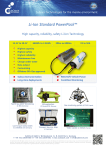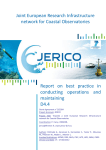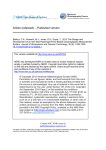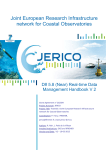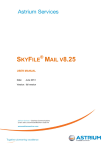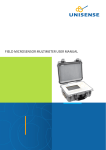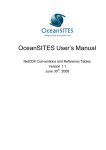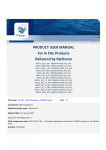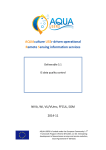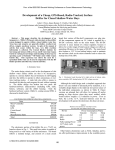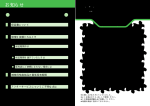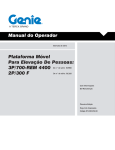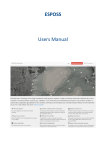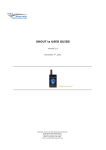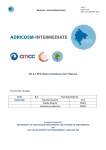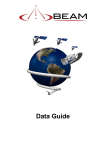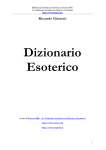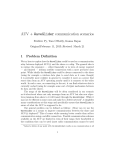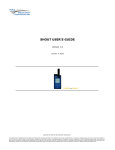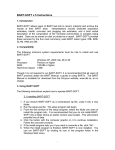Download D1.4_Jerico-Label
Transcript
Joint European Research Infrastructure network for Coastal Observatories JERICO Label Definition D1.4 Grant Agreement no° 262584 Project Acronym: JERICO Project Title: Towards a Joint European Research Infrastructure network for Coastal Observatories Coordination: P. Farcy, IFREMER, [email protected], www.jerico-fp7.eu: Authors: G Petihakis, Rajesh Nair, Mark Hartman, Patrick Farcy Involved Institutions: HCMR, OGS, NERC, IFREMER Version and Date: 2.0 – 31 Mar 2014 Table of Contents Table of Contents......................................................................................................................... 3 1 Document description ........................................................................................................... 5 2 Executive Summary ............................................................................................................... 7 3 Introduction ............................................................................................................................ 8 4 Main Report ............................................................................................................................ 9 4.1 Definition .........................................................................................................................................9 4.1.1 Criteria ........................................................................................................................................9 4.1.2 Classification Scheme ..............................................................................................................12 4.2 Infrastructures ..............................................................................................................................13 4.3 Rules applied ................................................................................................................................15 4.4 Nomination of the Label...............................................................................................................15 4.5 Protection of the Label.................................................................................................................15 4.6 Update of the Label ......................................................................................................................15 4.7 Mitigating measures .....................................................................................................................16 4.8 Environmental Impact ..................................................................................................................16 4.9 Recommendations........................................................................................................................17 4.9.1 Recommendations on sensing technologies ............................................................................17 4.9.2 Specific recommendations for coastal fixed monitoring platforms............................................19 4.9.3 Specific recommendations for ferry boxes................................................................................27 4.9.4 Specific recommendations for gliders.......................................................................................30 4.9.5 Qualification and testing ...........................................................................................................34 4.9.5.1 Define a life cycle of the equipment....................................................................................................34 4.9.5.2 Define the list of equipment parts to be tested ...................................................................................35 4.9.5.3 Define the type of tests to be performed ............................................................................................35 4.9.5.4 Define the required testing facilities....................................................................................................35 4.9.5.5 Test archiving .....................................................................................................................................35 4.9.6 Recommendations on Operating Issues...................................................................................36 4.9.7 Recommendations for Deployment-Installation ........................................................................42 4.9.8 Recommendations for Maintenance .........................................................................................47 4.9.9 Recommendations for Biofouling prevention ............................................................................50 4.9.10 Recommendations for Metrology-Calibration .........................................................................51 5 Future Plans.......................................................................................................................... 53 6 Annexes and References..................................................................................................... 54 JERICO –WP1-D1.4-30_07_2013-V1.1 .3 JERICO –WP1-D1.4-30_07_2013-V1.1 .4 1 Document description REFERENCES Annex 1 to the Contract: Description of Work (DoW) version XX Document information Document Name JERICO Label Definition D1.4 Document ID JERICO –WP1-D1.4-31_03_2014-V2.0 Revision 3.0 Revision Date 05/05/2015 Author Georges Petihakis and all Security History Revision Date 1.0 23/05/2013 G. Petihakis 1.1 30/07/2013 P. Farcy 1.2 09/09/2013 G. Petihakis 1.2.1 25/09/2013 J. Foden 1.2.2 20/10/2013 R. Nair 1.2.3 29/11/2013 J.F. Rollin 1.2.4 21/02/2014 G. Petihakis 1.2.5 17/03/2014 G. Petihakis 2.0 31/03/2014 First deliverable version G. Petihakis 3.0 12/05/2015 Final deliverable version G. Petihakis Modification Author Diffusion list Consortium beneficiaries X Third parties X Associated Partners X JERICO –WP1-D1.4-30_07_2013-V1.1 .5 This document contains information, which is proprietary to the JERICO consortium. Neither this document nor the information contained herein shall be used, duplicated or communicated by any means to any third party, in whole or in parts, except with prior written consent of the JERICO Coordinator. The information in this document is provided as is and no guarantee or warranty is given that the information is fit for any particular purpose. The user thereof uses the information at its sole risk and liability. JERICO –WP1-D1.4-30_07_2013-V1.1 .6 2 Executive Summary This document constitutes Deliverable 1.4 - JERICO Label Definition – of the JERICO project and it is an attempt to document several rules and recommendations that can be applied in setting up a coastal observatory. The JERICO Label is a set of criteria defined to ensure some standardisation and interoperability, and the quality of data for coastal observatories. It contains mandatory aspects, in point of view expressed and experienced in JERICO, as well as recommended solutions or options. This document is one of the main JERICO deliverables to be issued during the 4-year period and finalized towards the end of the project. It informs on the definition of the label and its implementation modalities, including rules, control and protection of the label. It includes recommendations and mandatory rules to be applied at different levels of the entire JERICO observatory network while the document will be updated with the other platforms used in the coastal observations and not included. It provides recommendations on sensing technologies for each platform, operating issues and deployment - installation. It highlights the importance of performing tests before any long-term deployment at the demanding coastal sea environment. It gives guidelines to define and implement a test plan. JERICO deliverables on Operation Best Practices, Biofouling and Calibration become a reference of the JERICO Label as soon as they are delivered. This document needs to be updated continuously with the evolution of technology, of gained experience and new needs. JERICO –WP1-D1.4-30_07_2013-V1.1 .7 3 Introduction The JERICO partners introduce the concept of a JERICO Label in order to: Acknowledge a consensus on guidelines for best practices in the design, the implementation, the maintenance, the data policy and the valorisation of operational coastal observatories; Achieve fair recognition of the quality of the managed observatories for the partners and all new comers that comply with this Label; Help stakeholders becoming aware of the European interest in the development of high quality coastal observatories; Foster a wider market for the industry in sensor technology and platforms based on the agreed recommendations. To define the JERICO Label the following are taken into account: The heterogeneity of the coastal observing systems to address the multiple space and time scales that characterise the variability of the coastal ocean; The compliance with other normative efforts (EU projects such as SeaDataNet & MyOcean, EU initiative EMODnet); The specificity of the coastal environment; The heterogeneity of the processes and interacting scales; The advancements on the observing technology and data transmission and availability; and The advancements on the scientific knowledge of marine ecosystem processes. The above make clear that the best definition of a JERICO Label is that of “fit for purpose”, where each observation system must show that it fulfils a set of requirements emanating from the observational purpose. A diversity of economic drivers and scientific objectives has resulted in a range of coastal monitoring operators, which JERICO can bring together in a community and promote. The perceived mechanism is an audit procedure, which describes the equipment, maintenance operations, the calibration, and anti-biofouling procedures as well as the data processing and handling of participating observatories, as described in the main report. For the JERICO Label to be successful it requires as much publicity as possible with the tools offered by WP6. It is important to attract other teams outside the JERICO community to adopt the Label. This will be achieved through: Presentations at international conferences and events Instant recognition through a JERICO Label logo. JERICO –WP1-D1.4-30_07_2013-V1.1 .8 4 Main Report 4.1 Definition The JERICO Label is a set of criteria defined to ensure some standardisation and interoperability, and the quality of data for coastal observatories. Observation systems certified by the JERICO Label will be internationally recognised. 4.1.1 Criteria Considering the wide variability of observational needs and methods in the coastal environment a “Fit for Purpose” approach is used. A set of criteria in a form of a comprehensive bullet list will be applied and the results will determine at what level the infrastructure/partner stands regarding the labelling from JERICO. More specifically: Sustainability The sustainability is a critical issue for each infrastructure/platform especially in the coastal area where funding is limited to national funds. o Although financing of coastal observation systems is often variable, a 5-year funding road map from National and/or International sources is required. o Long time-series and, when possible, synopticity of the integrated multi-platform observing platforms is considered an advantage. Operationality A key aspect of an efficient operational observing system is the streamlined processing of real time and delayed mode data, which takes the data from raw to quality assured. Considering the money and effort invested at EU level through numerous projects and initiatives such as SeaDataNet, EuroGOOS Regional Centres and MyOcean, the observation system must ensure that the flow of real-time and delayed mode data will be reliable, accessible and easy to distribute. To do so there are number of key issues which must be considered: o Data is quality controlled following documented protocols. o Free and open access according to Aarhus Convention on environmental data as expressed by IOC Data Policy (International oceanographic Commission UNESCO). o Long term archiving (more than 20 years) policy and implementation has to be performed for all types of data, including classified data. Archived datasets should be citable with a mention of the observation system. o Clear mechanism must be in place to guarantee data authorship traceability. JERICO –WP1-D1.4-30_07_2013-V1.1 .9 o Data availability (real time/near real time – delayed mode) compatible with the “observation method” (for example real time is required in operational systems). o Data frequency is compatible with the “observation purpose” capturing the time scale(s) of the observed phenomena. In particular the JERICO Label will be in compliance with the specification of the Group on Earth Observations (GEO) Label. The main goal of the Label is to specify an approach on how to judge the quality of data, based on the completeness of information as to how the data have been acquired, i.e. completeness of metadata description. Observing purpose: Considering the big variability between coastal observatories and the peculiarities of the coastal environment a “Fit for Purpose” approach has been chosen. Thus in terms of measured parameters the observation system must have: o Primary or Core Parameters. These are basic parameters required for the specific observing purpose following the UK-IMON core parameter list. o Secondary Parameters. These are additional parameters which are ‘good to have’ and although don’t fall within the “Primary or Core” category, they are also measured. Benthos Mammals Pathogens Phytoplankton Zooplankton Fish OTHER Sustained Resources BIOLOGICAL Public Health National Security Natural Hazards Weather & Climate Ocean Processes Marine Operations “Fit-For-Purpose” Parameter List JERICO –WP1-D1.4-30_07_2013-V1.1 .10 Temperature Contaminants Dissolved Nutrients Dissolved Oxygen CO2 Partial Pressure pH Acidity OTHER Sustained Resources Public Health National Security Natural Hazards Marine Operations Weather & Climate Ocean Processes OTHER Sustained Resources Ocean Processes Salinity Public Health PHYSICAL National Security Marine Operations CHEMICAL Natural Hazards Weather & Climate Seabirds JERICO –WP1-D1.4-30_07_2013-V1.1 .11 Sea Level Surface Waves Surface Currents Optical Properties (e.g. CDOM & SPM) Heat Flux Ocean Colour Benthic Habitats Wind Speed & Direction Surface Air Temperature Tidal Stream Flow An important issue is the specifications of the various sensor types in terms of range and accuracy. Although both characteristics will be judged against the observational purpose, it is mandatory that the sensors be registered in a database accessible under open data principles. 4.1.2 Classification Scheme In order to issue a Label that would be used to characterize a large number of different infrastructures, systems and involved procedures, operating all over the European seas a classification scheme is necessary (Figure 1). Label schematic: JERICO –WP1-D1.4-30_07_2013-V1.1 .12 New Entry: New System (Sensor, Platform, Infrastructure) infrastructure enters JERICO scheme. Standard Level: The System (Sensor, Platform, Infrastructure) complies with the “fit for purpose” criteria with minor discrepancies. Full Level: The System (Sensor, Platform, Infrastructure) complies with the “fit for purpose” criteria and may also hosts extra parameters. Figure 1: Three levels of accreditation in the JERICO Label: New entry, Standard level and Full level. 4.2 Infrastructures The aim of the JERICO Label is to include all European coastal observing systems avoiding any rigid framework, which will limit its practical use. However considering the present status in coastal European marine research observatories three major types are initially identified and thus dealt herein. Infrastructures not included in JERICO such as coastal radars, drifters, ARGO profilers, HF radars etc will be added at a later stage. Furthermore as observation methods progress, new infrastructure types will be included in the document during the update procedure. It is acknowledged that within each type of coastal system there is significant variability. The three different types of observing systems included in JERICO are: Fixed platforms o Buoys o Platforms o Coastal stations JERICO –WP1-D1.4-30_07_2013-V1.1 .13 o Stand-alone sensors (e.g. tide recorder) Ferry Boxes: o Passenger ships o Cargo ships o Research vessels Gliders: o Autonomous surface vehicles (e.g. wave gliders) o Autonomous underwater vehicles (e.g. buoyancy gliders) JERICO –WP1-D1.4-30_07_2013-V1.1 .14 4.3 Rules applied The JERICO Label shall not supersede existing legal or safety regulations or requirements and in most cases applies as a subsidiary to existing standards. The JERICO Label will not define technological solutions but technological specifications and minimum performances; technology changes over time and operators must endeavour to adopt innovative instruments, if they result in improvements. Furthermore explicit technological recommendations may infringe EU trade and conflict-of-interest regulations. 4.4 Nomination of the Label Upon request of a partner the JERICO Scientific Committee will consider whether an observation system and one of the three levels of the JERICO Label may be awarded, according to the level it fulfils. The Label will be awarded for a three-year period. Each request will be evaluated by a dedicated Committee, against the above-described criteria. For those observatories not meeting any of the levels described above, recommendations are made in the form of a road map. 4.5 Protection of the Label The JERICO Label is neither linked to any responsibility of its authors, nor to their organisations nor to the legal bodies funding their activities. No liability is attached to its mandatory requirements. The use of the Label requires the JERICO Label and the JERICO project web site to be referenced where possible. 4.6 Update of the Label The Label will be updated every 3 years. The sustainability of the Committee in charge of the Label will be addressed as a topic of the sustainability of the JERICO consortium considering that the Label Committee needs to be linked with a permanent European group such as EuroGOOS. Furthermore an agreement with ESONET and FixO3 Label committees may be also needed. JERICO will propose the constitution of this permanent group by the end of JERICO project in 2015. JERICO –WP1-D1.4-30_07_2013-V1.1 .15 4.7 Mitigating measures Not all observation systems will comply with the JERICO Label rules. In the case of an infrastructure not fulfilling all the requirements, when good reasons can be advocated, the Label attribution will be accompanied with either a restriction mentioned or a mitigation suggestion, which will have a time limit within which the observation system must be brought into compliance. 4.8 Environmental Impact Observatories awarded the JERICO Label should: Adopt a precautionary approach, e.g. in deploying, maintaining, recovering and operating the observatory infrastructure Pay attention to the effect of acoustic or optical devices on sea mammals and other organisms Ensure that electrical and acoustical noise are below the levels identified in the OSPAR agreement. Strictly follow the rules and recommendations of international bodies such as IUCN and ICES. Minimise the disturbance to species and habitats during fieldwork Seek permission for fieldwork in marine protected areas, where necessary Retrieve all deadweight or unused devices. JERICO –WP1-D1.4-30_07_2013-V1.1 .16 4.9 Recommendations The acquired experience of JERICO partners and the JERICO deliverables from WP3 and WP4 on a wide range of issues has allowed an extensive list of recommendations. Although not obligatory these are “good to follow” recommendations. 4.9.1 Recommendations on sensing technologies Although the purpose of the Label is not to direct towards specific technological solutions, the long experience of the JERICO partners in marine observations and the different technologies used must be brought into the Label, particularly in those cases where a sensing technology is out-dated and problematic. Main issues include: Pumped systems vs. un-pumped, The main difference of pumped and un-pumped oceanographic systems in terms of operation is the energy budget that it is increasing rapidly with the usage of a pump. On the other hand the systems equipped with a pump perform more accurate measurements since the water flow can be precisely fixed in order to overcome effects such as thermal lag and sensors hysteresis due to different response times of each sensing element of a system. Forced flow can also improve the system tolerance to fouling since there is no stationary water mass, in the system internal circuit that might provoke production of organisms. Although the pumped vs. un-pumped issue has been addressed long time ago with the use of the first versions of casting CTDs and the improvement that the usage of a pump offered in the data quality there are still some limitation for the pumped systems. Especially in fixed station and gliders where the energy budget is limited the use of pumping can decrease the operational endurance of the system. In the ferry box systems where there are not any energy limitations the usage of pumps is a common characteristic that allows them to operate safely even under the carrier ship waterline. Open-path systems vs. closed-path, There are two basic types of sampling systems that are commonly used for measurements in the marine environment: open and closed or semi-closed. In the open systems the sensing elements and apparatus are exposed in the surrounding water while in the closed path systems the equipment is usually enclosed in flow tubes and special design chambers. Each choice has advantages and disadvantages that should be taken in account. The open path systems usually used in fixed platforms and gliders are considered to be more precise regarding their measurements but the price to pay is that the sensing elements are exposed to environmental stresses. This can minimize a lot the operation endurance especially in high productive environments where the fouling can cause problems with the data quality even after some days of deployment. The close bath systems, used in FerryBoxes and in some fixed platforms, are more protect against fouling but the data must be reprocessed in order to eliminate the effect of the thermal heat due to forced flow of water and similar factors that cause erroneous measurements. JERICO –WP1-D1.4-30_07_2013-V1.1 .17 A “medium” between open and closed path systems are ‘‘shuttered’ systems where the sensing elements are covered between measurement cycles usually with a copper shutter. This solution has been proven really effective especially in moored optical sensors. Conduction vs. induction, Oceanographic conductivity/salinity sensors can be categorized in two groups in terms of their operational principal. Both induction and conduction sensors are being used for decades to measure the salinity of the seawater. Both types of sensors have been proved effective in the field and nowadays thousands are installed and operate in all types of sea observatories. The main advantages of inductive sensors are robust construction, and that to preserve the geometry factor they can be serviced and clean easily. There are no electrodes, so there is no possibility of their damage. Inductive sensors usually have a fairly large hole, which permits free flushing. The main disadvantages are that a significant part of the measurement is external resulting to errors when this external field is under the effect of fouling and surrounding equipment (eg metallic parts, batteries packs etc.). The electrode cell type (inductive) sensors have no external field so the antifouling protection is more effective than the conduction sensors and there is no influence from nearby equipment. In addition the electrode cells require flushing in order to operate effective especially for measurements in small-scale times and although the cells are more robust against fouling their cleaning procedure is more demanding than the conductive sensors. Wet chemistry vs. gas tension Wet chemistry sensors are using mechanical systems to obtain sample add reagents and transport the mixture in the detector. This type of sensors permitted to obtain measurements of parameters that would otherwise it will require continuous sampling and analysis on a lab. Due to their construction with a lot of parts there are mechanically more complex and larger than other sensors and demonstrate high power consumption. That’s for the ideal platform to host a chemical analyzer is a FerryBox but can be installed in a fixed platform too. Gas tension sensors use permeable membrane and a high-precision pressure sensor or an optical system to measure the dissolved gases of the seawater. This type of sensors although they demonstrate slow response time have been deployed successfully to a numerous of fixed platforms all over the world. Optical vs. electrochemical There two types of sensors used form dissolved oxygen measurements in the marine environment. Electrochemical sensors that use an anode, cathode, and oxygen permeable membrane and optical sensors equipped with a foil that measure the dissolved oxygen using the light emission characteristics of a luminescent reaction. The main limitation of electrochemical sensors is that because of the chemical reaction that constantly takes place, a buildup of oxidized material will begin to form either on the anode or in the electrolyte solution. This buildup must be removed JERICO –WP1-D1.4-30_07_2013-V1.1 .18 regularly in order to keep the sensor at peak performance. The optode foil does not demand so often maintenance and calibration making it more appropriate for longer deployments. Another vital specification to keep in mind is the response time of the sensor. The response time for an electrochemical DO sensor is shorter than the optical sensors making it more suitable for applications where the DO concentration is expected to change rapidly fast (eg CTD castings). The optode does not require to be connected to a pump or a flow through circuit in order to operate properly making it more effective choice in platforms with power limitations. Wavelength (chlorophyll, turbidity, phycocyanin) The first optical sensors used in operational oceanography where single channel devices measuring just one parameter eg. Turbidity, Chl-a etc. The advance in electronics and optical technology in the previous decades gave birth to state of the art devices that are able to measure more than one parameters using emissions with different wavelengths. As an example one of the most common sensors used now in the oceanographic observatories will measure chlorophyll fluorescence at 470 nm and turbidity at 700 nm using the same detector. This detector is capable to measure both the fluorescence emission and the scattered light from particles in the seawater. Moving even more forward new sensors that are able to perform multispectral in situ analysis with minimum power requirements are being developed and will be an added value in all types of sea observatories. 4.9.2 Specific recommendations for coastal Fixed monitoring Platforms Energy Issues The size of the platform and the distance to coast plays an important role in the energetic requirements of a platform. As the platform size increases the on board installed sensor possibilities increase, as well as the power requirements and possibilities of generating more energy. On cabled platforms the distance to coast is an important aspect when using cabled power supply. As the cable length increases the installation price increases, the potential risk increases, maintenance cost increases and so on. Cable connected platforms to shore have unlimited power supply whereas not connected platforms need to store and/or generate the required energy for the operation period. Sealed lead acid batteries should normally power fixed platforms with no cable connection to land. The units should be sealed against water ingress to a depth of 1 meter. There should be sufficient capacity in the batteries to power all the systems operationally for at least 4 months without any recharge. This has consequences on the power management, as batteries are quite heavy. Therefore sensors, data collection systems and data transmitting systems with the lowest energy consumption possible are desirable. The use of sensors operated on their own batteries avoiding the use of the platform’s main batteries is a good practice in order to extend the platform operation cycles. Batteries installed on board the platforms should be recharged to achieve the energetic autonomy. Solar panels and wind turbines are the used ways to produce energy. Although solar panels are more efficient than wind turbines (100% vs. 10% at JERICO –WP1-D1.4-30_07_2013-V1.1 .19 sea level), a small platform can generate more energy using wind than sun in its reduced space. Yearly insolation and wind regimes characteristics determine the choice. Solar panels They have application on buoys, coastal stations, and standalone sensors. In winter in northern regions there is no enough light. Due to this fact the solar panels must produce much more energy than needed for keeping the system running because the battery must be charged to maximum capacity before winter. Therefore in winter the solar panel deliver no noteworthy contribution to the energy supply of the station. As consequence small platforms do not have the space and buoyancy to install solar panels. Maintenance requirements are low limited to cleaning the panels. In platforms where bird droppings are a problem, the installation of bird spikes around the solar panel can extend maintenance visits periodicity. Wind turbines They have application on big platforms and land based remote platforms. There is a need for more maintenance, as there are mechanical parts such as blades, bearings and axes. Often there are problems with fisherman, rough weather and corrosion but a useful trick is to put a diving suit arm or leg on the upper part of the pole to avoid sea spray entering the direction bearings. Diesel generators For some important platforms, a diesel generator is also feasible, at least to complement other sources in case of lack of resources (dark or no windy periods). Connectors – Electrical and Mechanical Connectors and splices are a critical component in fixed platforms because they provide connectivity between the different modules in the platform. Underwater, wet and surface-mateable connectors are used. Underwater-mateable connectors are used for joining up electrical circuits underwater without having to bring any element to the surface. They provide a termination of an underwater cable containing electrical conductors and have features that protect the conductors from the external environment. This allows divers, ROV’s or AUV’s to facilitate the connection of the two halves underwater. The capability of being able to connect platform modules underwater opens a wide range of actions to accomplish the installation and maintenance operations. The wet-connector types most commonly used by the oceanographic industry are: Rubber molded wet-mate connector Metal shell wet-mate connector JERICO –WP1-D1.4-30_07_2013-V1.1 .20 A major consideration in the selection of underwater –mateable connectors is the intended mode of operation with reference to its specification and hence price. A correct connector selection should ensure the intended service, for the required lifetime, at the correct time. Selecting underwater connectors factor beyond the obvious; cost, availability and size, are; suitability, ease of use, reliability and the consequence of connector failure. Generic failure modes and causes: 1. Corrosion: Due to incorrect metal selection or incorrect installation of the connector for a particular application. 2. De-lamination: Cathodic delamination occurs when an electrochemical cell is formed between the connector body and a cathodic protection system such as a zinc anode or induced current. 3. Elastomer degradation 4. Damage: The main source of operational problems with a multitude causes as: Physical damage to the body or contacts, excessive use beyond its life-cycle without maintenance, excessive force on a connector body, excessive temperature, excessive pressure, improper installation and maintenance or improper selection for application. 5. Premature unlatching 6. Seal failure: Seal failure can cause water ingress leading to connector degradation. 7. Inadequate long-term protection The exposed wet or dry-mate connector’s protection with tapes (e.g. shrinkable tape) is a good practice since it reinforces a system’s potential weak point. This practice will slow down connector’s deterioration as a result of its exposition to the rough environmental conditions. Shackles Recommended as connectors for being simple and secure. There are two basic configurations: Anchor shackles, are used to connect a buoy to the mooring and the mooring to the anchor. They are also used with thimbles and larger shackles. Chain shackles, are used to connect two segments of chain together and are sized equal to the chain diameter. JERICO –WP1-D1.4-30_07_2013-V1.1 .21 In addition to the bow configuration, there are three basic pin styles: Round pin shackles, utilises a cotter pin only to prevent the shackle pin from falling out. This is not very secure and should not be used in long-term deployments. Screw pin shackles are not recommended for buoy moorings since they are not very secure. Safety shackles, utilise both a bolt pin and a cotter pin for security. This is the recommended shackle for buoy moorings. Mooring lines – Design - Components The mooring line is to provide a long term mooring that would be simple in design, fabrication and deployment, and relatively low in cost. Most mooring systems are required to accommodate underwater sensors that complicate the mooring systems. Moorings without subsurface oceanographic sensors allow for simpler, cheaper and easier deployments. Three standard designs are used today as described in detail in D4.4 Best Practice Report. The mooring type and specific design to be used for a particular mooring will be determined by the system considerations and the site location. The main aspects are: Buoy hull type: The designation of a particular hull for a selected mooring site will aid in determining which mooring system will be used. Smaller hulls have limited buoyancy that may limit the size or amount of line and/or chain being used in the mooring in deep water. The type of buoy hull will also determine the mooring component sizes through strength requirements; larger hulls exert a greater load on the mooring and thus require greater mooring strength, which is essentially accomplished though component size increases. Sensors and instruments: Underwater sensor and instruments integration and operation will require special lines or mooring designs. Currently, inductive cable is a common line material at the upper middle mooring. Water depth: This is the main criterion that will determine which particular mooring system can be used for a given site. This information is usually obtained from a nautical chart for design purposes and then verified on scene during mooring operation. Bottom nature: The deployment site should be relatively flat with no steep slopes, dropoffs or seamounts. The type of bottom may also be of concern to the mooring system, primarily in shallow water (Poseidonia beds for example). Environmental conditions: Each site has its own expected weather conditions, which will determine the mooring line design criteria. As an example, NDBC moorings are designed for survival in 50 m·s-1 winds, 1.5 m·s-1 current and 10 seconds waves. The possibility of the buoy being subject to ice loading will greatly affect the performance of a mooring. Moving ice can produce loads as much as 20 to 30 times the normal load. Spring ice melting in northern latitudes affects adversely the induction based underwater data transmission systems operation. JERICO –WP1-D1.4-30_07_2013-V1.1 .22 Design life: The upper mooring design life is shorter than the middle and lower sections. Special considerations: Where heavy fishing occurs, watch circle may have to be reduced. To obtain any mooring designs several elements must be combined, paying attention to all of them in order to avoid weak points. A proper selection of materials and construction as well as a correct combination of elements are very important, since they affect the cost, characteristics and longevity of the mooring. The components most commonly implicated in mooring line failure are mentioned in the table below: Hardware Screw pin shackles Wire rope Failure Wire rope thimbles Swivels Pin loss through failure to weld shut or properly tie or mouse with stainless wire. Thread corrosion, which loosens and weakens the pin. Water penetration inside the coating and corrosion. The use of thimbles not designed for synthetic ropes. Rope stretch allows the thimble to work out the eye splice. Rusting of the inner rope bearing surface causing abrasion of the line. Use of defective hardware. Use of ball bearings. Not suitable for long –term use in sea water, the grease seal breaks down. Both synthetic rope material and construction are very important to fulfil the desired characteristics of the rope. Today’s technology offers more advanced and specialized synthetic ropes, which often are very expensive, than the ones discussed in this report, but these are restricted to the use in custom moorings. Ideally, a mooring should consist of one continuous length of rope, free of knots, splices or anything to decrease its overall strength. End terminations should be eye splices. These should be made using the proper thimble and splicing techniques. The thimble will protect the rope from abrasion and fatigue, as the splicing will retain a huge part of the rope strength. The use of knots, cable clamps and other devices anywhere on the rope should be avoided, as they will reduce the rope strength. Upper and lower moorings main component, it is used as rope link in the middle mooring. The chain link size used will be in accordance with the buoy and mooring line dimensioning. Low carbon steel forged chain is adequate for buoy mooring purposes. Uniform size of links, good welds and documentation proving that quality assurance testing has been performed are aspects to check when purchasing chain. Chain can be used in several mooring operations, although deterioration caused by friction and corrosion has to be checked. Some sensor measurements such as hydrophones can be affected by the use of chain sections along the mooring. JERICO –WP1-D1.4-30_07_2013-V1.1 .23 Data transmission Real-time data transmission, from platform to shore and from submerged elements of the platform to the surface, can be accomplished using different methods. The combination of these methods at the same platform is a common practice to operate real-time fixed platforms. Apart from the primary data transmission system, the integration of a secondary communication system is desired, in case of primary system failure or emergency. The main aspects driving the data transmission system from the platform to shore are: Location: Distance to land. Economic: From free data transmission to thousands €/year/platform Energy: Different power consumption The main aspects driving the data transmission system in the platform are: Platform type and design: The platform design will allow or prohibit the use of certain data transmission systems. Location: Environmental conditions may pose limits to some systems. Economic: From cheap non armoured cables to high tech cables or acoustic modems To deal with high transmission costs or with technical limitations, the data logger configuration could include different data acquisition protocols, first, for real-time transmitted information, and secondly, for raw and more exhaustive data recorded on hard disc on board. The development of cell-phone, satellite and RF telemetry has made real-time, unattended, remote oceanography, increasingly practical. However, before these telemetry techniques can be exploited the data must be brought to the surface. In addition to the traditional direct-cable communication technique, acoustic, inductive and optic techniques have been developed during the last years. As fixed platforms, such as buoys or platforms, can be located in remote areas, the cost of laying cable becomes prohibitive. Thus there is need to seek for other data transmission solutions. Two-way telemetry is desirable since sensor configurations and platform operation modes can be remotely modified. Telemetry systems should be tested as much as possible; prior to the installation or deployment in laboratory, on the way to the deployment site, while a pre-deployment realistic configuration and testing is desirable. Undersea cabling solutions, electrical and fibre optic have proven to be robust and reliable data telemetry methods and can offer virtually unlimited power and bandwidth for data collection and transmission. However, implementation of undersea cable solutions is quite expensive and requires environmental permitting. Other options to transmit data from platforms to shore are satellite, radio JERICO –WP1-D1.4-30_07_2013-V1.1 .24 frequency and cell phone telemetry. System Undersea cabling Pros Cons Robust and reliable Very expensive (purchase and installation) Unlimited power and bandwidth Environmental permission required Maintenance Satellite Robust and reliable Quite expensive Global coverage Limited data Radio frequency Free of charge Large amounts of data Requires line of sight or repeaters Low power Cell phone telemetry WiMAX Low power Geographically restricted Huge bandwidth Power requirements Choice of materials – corrosion and ageing recommendations Buoys, chains, wires, ropes, clump weights, releasers, metallic and concrete structures, hulls….. the material list in a fixed platform can be large. The material used in each element of the platform should be chosen by its ability to withstand the marine environment’s rough conditions. The correct choice of materials in the design phase, as well as good protection of some elements in the operation phase is important. Before the integration of a new material in the platform it always should be tested. A Test Plan Definition is recommended prior to any change. Some marine hardware materials should be avoided as they can accelerate corrosion of other materials, thus special precautions are necessary. The corrosion prevention is an important aspect when designing a platform. Corrosion is a very familiar problem when dealing with hardware in the marine environment. Correct selections of the used hardware as well as its correct integration are key aspects to succeed. Although a lot of bibliography on this topic is available, the best understanding from corrosion on fixed platforms comes from experience. When two different metals or metal alloys are in contact in seawater, corrosion will occur. The reason is their different electrochemical potentials, the bigger the electrochemical potential difference hence the bigger the corrosion. Galvanic series lists the metal’s activity, the passive metals will cause accelerated deterioration of the more active metals when in contact. The use of metals with similar electropotentials will minimize the corrosion. Ideally the use of the same material for the entire platform is the easiest way to match potentials, but this is not JERICO –WP1-D1.4-30_07_2013-V1.1 .25 always possible. Some practical measures to prevent or reduce corrosion are: Sacrificial anodes. This is commonplace in metallic submerged structures. Zinc and aluminium are used to protect more passive metals from corrosion by “sacrificing” themselves. This can be found in clumps physically attached to cathodes or as paints used to coat the cathodes. The sacrificial material must be in electrical contact with the metal being protected. Exposed areas. The “Law of Areas” has an effect on corrosion activity. A relatively small cathode or passive area in contact with a large anode or active area. A stainless steel pin in a carbon steel safety shackle will exhibit very little activity, while a large cathode will quickly deteriorate a small anode. For this reason is not a good practice to coat an anode such as an aluminium buoy. Isolation. The metals can be electrically isolated with non-metallic bushings, synthetic ropes or by coating the cathode with inert paints or epoxy. Earth connection. On platforms connected to a shore line electrical power feed will have to have the main metallic structure connected to earth for safety reasons. In such cases the use of galvanic isolators is recommended. Any minor current leakage in the system can accelerate the corrosion process. Stress corrosion. Certain metals, such as higher strength carbon or alloy steel, are highly susceptible to accelerated corrosion due to stress. This is most often seen in threaded bolts and pins. Oxygen corrosion. Stainless steels commonly show this type of corrosion as they rely on oxygen to maintain a protective coating. Area or conditions which do not permit flow of oxygenated water, such as under clamps, bolts or where the metal is covered by bottom sediment or fouling organisms, will cause the stainless steel to become active. Rules for usage. Somme common hardware alloys and combinations, which have least problems with corrosion: Stainless steel. The law of areas is important with stainless steel. Used on shackle cotter pins, bolts and hatch dogs. Magnetic stainless steel needs to be avoided in seawater. Stainless steel swivels and cables are not worth the expense considering the dissimilar metals and oxygen depletion corrosion problems. JERICO –WP1-D1.4-30_07_2013-V1.1 .26 Bronze. Used on thimbles. Very effective when used with long length of mooring chain, where the area of exposed bronze is small relative to the more active steel. Carbon steels. Low carbon steels are used extensively in marine uses. High carbon steel should be avoided; it is subject to severe pitting problems and crevice corrosion. Steel platforms should have sacrificial paint or anodes for longer, and safer, service. Need to pay special attention to the splash zone since it will have extensive rust problems if protection is not provided. Aluminium. It is usually only found on buoys. Magnesium alloyed marine grade aluminium is recommended. Painting is not recommended, except where a colour coding is required under existing maritime regulations, as aluminium creates a very good oxidised protective coating. 4.9.3 Specific recommendations for ferry boxes Connectors No particular care is required as most of the connections are on open air and not in the water. However it is important to observe that the instruments are properly connected and that wires and connectors are regularly inspected. Data - Quality Check – Transmission - Dissemination Data from automated FerryBox measurements should be sent to an oceanographic data centre in near real time if feasible. The status of the FerryBox (standby, cleaning, operation etc.) as well as the monitored flow-rate is used as criteria for the functionality of the FerryBox. Data are only passed if the system is in operation mode and the flow-rate is ok. Furthermore, the standard deviation of the averaged data (average of 20-60 sec) is used in order to flag noisy values (e.g. optical sensors disturbed by air bubbles in stormy seas) or frozen values. Another criterion is the range check where a specific range of the physical value in a certain area will be checked. Quality control and flagging follows the recommendations of the Data Management, Exchange and Quality Working Group (DATA-MEQ) within EuroGOOS. The raw data (QC level 0) should be stored without modifications. The first step in the QC-process should be carried out automatically using algorithms to flag or remove out of range data etc. to reach QC level 1- MyOcean has described this process in some detail. Scripts for carrying out this have been developed by several institutes and code is available e.g. in the Python programming language (open source) and in MatLab (Mathworks Inc.). Different examples are found in the D4.4 Best Practices Report. Data are flagged according to MyOcean flagging scheme. JERICO –WP1-D1.4-30_07_2013-V1.1 .27 The QC1-level data should be made freely available to the oceanographic community in near real time. The next step in the QC process is to control the data visually on a regular basis as not all errors such as small drifts or sudden jumps can be detected automatically. QC level 2 should be reached if the automated measurements can be compared with data from reference measurements (water samples analysed in an oceanographic laboratory) and with historical data from the same geographic area and season. This is conveniently made with the same interval as the service interval of the FerryBox-system in question, often every week or every two weeks. A semiautomated system for this may be developed using different databases and scripting software. Problems noted, e.g. bio-fouling of sensors etc. may now quickly be rectified during the next service visit to the ship with the FerryBox system. The last step in the QC process to reach QC level 3 should be carried out yearly when the whole data set for the year is plotted and compared to reference samples and historical data. FerryBox Tools is useful also for this. The QC3-level data should be made freely available to the oceanographic community for long-term use. In some cases multiple sensors measure one parameter. For example temperature may be measured by the combined temperature/conductivity probe, the oxygen probe, and a sensor for chl-a fluorescence as well as by a separate temperature sensor positioned near the inlet by the hull. By comparing the temperature data from the different sensors it is possible to identify problems with water flow and sensor function, e.g. stability. Following comparison of the match of the output from the different sensors a single output measurement based on the choice of the “best” most closely functioning instruments may be generated. Data from automated measurements and water sampling should be made freely available to the global oceanographic community after quality control. The existing systems developed by the Intergovernmental Oceanographic Commission (IOC) and the International Council for the Exploration of the Sea (ICES) should be used when suitable. Many countries have national oceanographic data centres, e.g. the United Kingdom and Sweden. If such a centre exists it should be used to store and distribute data. Another option is to select an institute that collects stores and distributes data for a region. These data centres act as nodes in a European network. Each node is responsible for collecting data, quality control and dissemination of data at the national or regional level. Data should be freely distributed using web feature services and similar techniques. In this way corrected data are automatically distributed to other data centres and users when corrections are made. The data distributed by the nodes should be collected at one, or a few, European FerryBox data centres. This centre(s) will make the data available in a coherent way and will also visualize the data on maps, in graphs etc. It should be noted that both near real time QC1 data and delayed mode QC3 data should be distributed in the same system. Choice of equipment After the first attempts by some FerryBox operators to build their own systems using stand alone commercial sensors, some commercial systems came on the marked and several sensor companies are now delivering FerryBox systems. JERICO –WP1-D1.4-30_07_2013-V1.1 .28 The JENA 4H-FerryBox is an automatic, low-maintenance measuring system to monitor water parameters, manufactured by 4H-Jena (http://www.4h-jena.de/). It was especially developed for continuous deployment on ships, in fixed platforms and in the sea or river monitoring stations. The modular architecture allows the integration of various sensors of different manufacturers, the connection of analysers and automatic samplers and in particular measurements in difficult media (e.g. sea water, oxygenated water etc.). The integrated automated cleaning feature prevents the growth of biofilms even at the beginning. The entire system is flushed with tap water, acidified water or even hypochlorite solution on a regular basis either daily or after each cruise. Due to this anti-fouling system maintenance is kept to a minimum. The SubTech OceanPack AUMS consists of several SubCtech products. It comprises for instance the proved LI-COR® pCO2 analyzer with the data management SubCtech SmartDI® (Smart Data Interface) data logger. This data logger is additionally equipped with various connection types to enable the integration of other probes or analyzing systems. The integrated "auto-calibration" function, for e.g. the pCO2 analyzer and optional automatic cleaning routine, enables the applications without supervision. The monitoring system is suitable for vessels and offshore work under rough environmental conditions. Battery operations - e.g. on buoys or remote measuring stations - are possible, as the power consumption is low. The AADI version of FerryBox named SooGuard consists of an automated package of different sensors designed for long-term installation on a ship of opportunity. The system offers easy maintenance and flexibility to collect data from a ship of opportunity. It is based around a 10 bar pressure housing for water-flow and measurements. Embedded sensors are connected to a SmartGuard data collection platform for data logging and telemetry. More details can be found on http://www.aanderaa.com/. The GO-SYS BlueBox is the central panel of a modular measuring and controlling system, designed by GO-SYS (http://www.go-sys.de/1/home/). It can be connected to both sensors (e.g. temperature, compression or conductivity) and actuators (e.g. relays, pump) by CANBus (Controller Area Network) technology. It is designed for multiple purpose not only FerryBox applications. In mobile use the attachment of a GPS for a continuous determination of its position is optionally possible. JERICO –WP1-D1.4-30_07_2013-V1.1 .29 In terms of commercial sensors available for FerryBox systems there is a wide variability off the shelf products. The core-measured parameters are temperature, salinity, oxygen, Chl-a fluorescence and turbidity and for each of those parameters there are numerous available products with advantages and disadvantages as described and analysed in detail in the Report of Best Practices (D4.4). Furthermore Automated water sampling devices are important parts of FerryBox systems. They facilitate sampling for parameters that cannot be measured automatically and also of reference samples for quality control of some parameters that are measured automatically. In addition water samples collected by automatic water samplers can be used to validate the sensor data on a FerryBox. Recently, passive samplers targeting contaminants have significantly extended the capabilities of FerryBoxes allowing a cost-effective monitoring of large areas. Flow detection Together with the pump used, pipe dimensions will determine to a large extent the flow through the system. Whether one should have a fast or low flow in the system will depend on the sensors used. However, flow rate has an upper limit determined by the production of bubbles. The status of the FerryBox (standby, cleaning, operation etc.) as well as the monitored flow-rate is used as criteria for the functionality of the FerryBox. Thus data must only be passed if the system is in operation mode and the flow-rate is ok. Multiple sensors measure quite often one parameter. For example temperature may be measured by the combined temperature/conductivity probe, the oxygen probe, a sensor for chl-a fluorescence as well as by a separate temperature sensor positioned near the inlet by the hull. By comparing the temperature data from the different sensors it is possible to identify problems with water flow and sensor function, e.g. stability. 4.9.4 Specific recommendations for gliders Gliders are a new-technology platform. It is very important to note that right from the start there have been efforts towards adopting common methodologies and protocols as well as harmonisation of equipment at European level. This helps coordinating the glider activities, reducing maintenance and calibration costs and managing the glider data flow. Infrastructure The concept of an infrastructure of a network of so-called gliderports emerged rapidly. Gliderports have been coined to describe infrastructures required to operate underwater gliders and manage the gathered data. The infrastructure contains several aspects that contribute to the overall task of glider operation. A key point in the design of a gliderport is the laboratory. It should be first furnished with the proper work surface and tools for electronic and mechanical work on gliders. A well-designed laboratory has easy access to facilitate transporting gliders and glider equipment. Furthermore, as it is common practice to test satellite communication and positioning systems prior to deployment, the JERICO –WP1-D1.4-30_07_2013-V1.1 .30 laboratory should also have easy access to an open space with unobstructed sky view. A glider laboratory should sport a crane that facilitates moving a glider between areas and be equipped with network connection (LAN or WLAN). Furthermore, the laboratory should be labelled with exit routes and emergency plans, in line with local health and safety regulations. For some type of gliders a ballast tank is a necessity. Letting a glider in the tank or removing it, can be done manually by two persons, but because of its weight of about 60 kg, it is preferable to use a crane for this task. That means that also from this point of view the work surface and ballast tank should be in each other's proximity so that the crane can service both locations. A pressure chamber can be useful to detect any leakages in the glider assembly or a sensor assembly. Despite this, the large costs mean that most institutes will do without. Ideally the pressure chamber should be large enough to contain the whole glider. Shelving is required for storing gliders, spare parts and regular and specific glider hardware tools. Convenient lifting tools (crane, carts) are recommended to move gliders (or parts) from one place to another. Data – Quality Check - Transmission - Communication Gliders gather enormous amounts of data while deployed at sea. Engineering, scientific and navigation data are collected approximately once every two seconds by the platforms. This leads to a high quantity of data that, from a very general point of view, needs to be extracted from the glider, converted to standard formats, verified, and exported to allow its public access. To perform all these processes a glider Data Management strategy is definitely needed by all European groups. Generally gliders make use of satellite communication for making a link with a server on shore. Although various nations or consortia have developed a number of satellite communication systems over the years, it is the Iridium satellite communication system that is used solely today. The advantage of the Iridium satellite communication system is that it provides a global coverage, in contrast with, for example, the Thuraya satellite system, which covers Europe, Africa, Asia and Australia, but not the Americas. Normally, a satellite connection is initiated using an embedded Iridium modem on the glider platform. A connection is established with a satellite and via possibly a number of satellites the connection is made back to land to The Gateway, a data centre in the US. From here the connection is relayed, either via a Public Switched Telephone Network (PSTN) to a conventional modem connected to the server on shore, or via the Internet using a TCP connection directly to the server. The latter method is commonly referred to as RUDICS (Router-Based Unrestricted Digital Internetworking Connectivity Solutions). The PSTN solution can have poor connection and data transfer rates in particular for users outside the US. Most likely this is due to occasionally poor quality transatlantic phone connection, across the Atlantic for users in Europe for instance. The RUDICS solution does not suffer from badly performing phone lines as the communication from the Gateway to the server is via the Internet. The JERICO –WP1-D1.4-30_07_2013-V1.1 .31 RUDICS system is therefore the recommended solution. The transmission costs are generally lower for the RUDICS system. Depending on the intensity of use of the glider, the break-even point can be expected to be reached rapidly or after a few years. Another way to use Iridium communications, which was chosen for the Spray, is through SBD (Short Burst Data) messages. This is similar to SMS and is generally cheaper than airtime but does not allow a fully direct link between land and the iridium phone like a terminal connection. FreeWave is a radio communication solution operating at the 900 MHz band. This allows users to establish a communication link with a glider up to a range of ~10 km (line of sight), depending on weather and sea state conditions and the height of the antenna. This system is only available for the Slocum glider and all the equipment needed comes with the glider package. All glider operators and glider DAC/GDAC ((Data Archiving Center and Global Data Archiving Center) have agreed on a data management system, which ensures all European glider data can be quality-controlled and disseminated in near real time. This system has been derived mainly from the one set up by Argo and OceanSITES international programs for profiling floats and moorings respectively. It must be noted that such an international data management system is too slow for pilots to use the data processed by this system. Each glider platform has a manufacturer-based data collection system and the glider operator decodes these data. Then, the data management system shall ensure all data are quality-checked and disseminated. The DAC is the facility set up by one or more nations/institutes to provide Real-Time and Delayed mode glider data to the users. It collects the data from the Glider Operator, converts to standard exchange format, applies standardized real-time quality control, delivers data to the GTS and GDACs within few hours of the surfacing and to PIs on a more relaxed schedule, coordinates glider data handling for the gliders under their control. The GDAC operates the data services where the master copies of the data reside. It doesn’t perform any additional individual glider QC activities. It is a central point for data distribution on Internet for all EGO gliders. It can perform data format transformation, of set up additional services (OGC viewing service, OpenDap/Oceanotron download services) to fulfil additional needs. An architecture based on a network of such actors has been actually set up to ensure the real time data management of all European gliders. It is presently fully operational for most of the glider operators and will soon be operational for the others as they develop chains compliant with this architecture and the standards developed by the glider community for both coastal and open-ocean waters. Glider data are transmitted in near real time each time the glider is at surface. These are binary compressed files with possibly a decimation of the data collected to reduce the communication costs for the real time data transmission. There are both technical and scientific data that have first to be decoded on land by the manufacturer software in a readable format. It is recommended that a glider operator does not rely only on the manufacturer's tools. They are generally very limited in terms of visualization, processing and contextualization and it is strongly recommended to use the more advanced MPATs (Mission Planning and Analysis Tools) that have been developed so far by the glider operators. It is important to realize that glider operators need to decode these raw data onthe-fly to visualize them as fast as possible in an oceanographic context, and to be able to steer the gliders in a convenient way. JERICO –WP1-D1.4-30_07_2013-V1.1 .32 The glider data not transferred in Real Time using the satellite connection are downloaded from the glider once it has been recovered, so-called Delayed Mode (DM) data. If there are DM data, it is recommended they are processed with tools compatible with the ones used in real time for the piloting and transformed into the agreed exchange format for the quality control procedures to be applied more efficiently. It is recommended the glider data are publicly available and quality-controlled within an hour (in RT, at least within 24h) for near real time applications. Choice of equipment Gliders are small autonomous underwater vehicles which were developed to carry out in-situ observations of the upper 1km of the ocean filling the gaps left by the existing observing systems. At the moment, there are 3 groups in the USA who have developed operational gliders: The Seaglider by University of Washington ; The Slocum by Teledyne Webb Research Corp ; The Spray by Scripps Institution of Oceanography. Although the designs are different, they have many features in common. They all have a small size (about 1m50 long and 20cm in diameter) and their weight is around 50kg in air (and +/-200g in water). They enhance the capabilities of profiling floats by providing some level of manoeuvrability and hence position control. They perform saw-tooth trajectories from the surface to the bottom of the ocean or maximum depths of typically 100-1000m (and recently 6000m depth), along reprogrammable routes (using two-way satellite link). An altimeter prevents them hitting the bottom. There is around ~2-6 km between surfacing when diving to 1km depth. They achieve vertical speeds of 10-20cm/s and forward speeds of 20-40 cm/s thanks to a ballast pump, wings, and rudders, and can be operated for a few months before they have to be recovered. They can record temperature, salinity, and pressure data and depending on the model some biogeochemical data, such as dissolved oxygen, different fluorescence and/or optical backscatters by using miniaturized sensors on-board. Other models have been developed. They have fewer track records and are not considered as operational than the 3 previous ones but could be soon used as well in a more sustained way: The Exocetus from Exocetus Development LLC, USA The Folaga from Graaltech, Italy The Seaexplorer from Acsa-Alcen, France The Sea-wing from the Shenyang Institute of Automation, China The Sterne from ENSTA-Bretagne, France JERICO –WP1-D1.4-30_07_2013-V1.1 .33 4.9.5 Qualification and testing Performing tests should be considered of prime importance before planning any long-term deployment at sea or deployment of costly instrumentation. The necessity of defining a test plan early in the development process of equipment is now a widespread and recognised issue. This is in order to get assurance the developed equipment brings the expected service in conformity with its functional specifications, taking into account the various conditions it will be submitted to during its lifetime. It is mandatory to write a Test Plan Definition Document for each piece of equipment to gather pertinent information on the items reviewed. It should be stated whether each qualification test will be valid for a series of identical equipment or will be performed individually on each piece of equipment, even if identical. Recommendation: this test plan may be inspired by the document NF X 10-812: http://www.boutique.afnor.org/norme/nf-x10-812/milieu-marin-materiels-immerges-essais-enenvironnement-et-recommandations/article/807713/faq (An English version (XP X 10-800) is available on IFREMER website: http://www.ifremer.fr/tsi/qualite/specif/31SE09.pdf). It is planned to enlarge this French standard to EN standard. 4.9.5.1 Define a life cycle of the equipment Listing the situations: home base storage, transport, temporary storage on operation base, transit to operation site, deployment, underwater maintenance, return to home base. Listing the situation parameters the equipment will be subjected to in each of the situations listed above: o The environment parameters (in situ natural environment and anthropogenic environment): temperature, air humidity, pressure, solar radiation; o The operations parameters: vibrations acceleration and mechanical shocks, thermal shocks. JERICO –WP1-D1.4-30_07_2013-V1.1 .34 Quantifying the range of parameters values. 4.9.5.2 Define the list of equipment parts to be tested Tests can be performed on some components, or on each of them (recommended), on some subassembly systems and on the complete system. Tests performed by manufacturers are encouraged as they provide a common reference quality level to the basic components used by a large community. 4.9.5.3 Define the type of tests to be performed Sensor laboratory calibrations: to verify sensor performance and determine the relationship between the measured physical parameter and output signal (cf. § Metrology calibration). Sensor data validation tests: These procedures are the ones that can be performed on site or on land with the minimum equipment required and can be a really helpful tool and a first step to ensure the desired data quality. The measurement validation actions and tests are NOT sensor calibration procedures. The calibration methods and Best practices are described in detail at the JERICO D4.2 Report on Calibration Best Practices. Environmental tests: to reveal possible conception, manufacturing or assembly deficiencies and to ultimately verify that the equipment is able to endure the “service conditions” of the different situations of life cycle and at each integration level (components, sub-assembly systems, complete system). Functional tests: to verify that the intended functions of the equipment are performed according to the specifications. Define the programme of measures and the functional checks – corresponding to the operation of the observation system – to be performed before, during and after each test. 4.9.5.4 Define the required testing facilities Give the type and description of the required facility (e.g. climatic chamber, water test basin, pressure chamber). Give also the main required characteristics (e.g. range of temperature, main dimensions) and performances (e.g. parameter variation speed). Identify existing testing facilities or necessary custom built installations. 4.9.5.5 Test archiving For each test performed, a Test Archiving File (TAF) should be produced. It should keep track of the JERICO –WP1-D1.4-30_07_2013-V1.1 .35 test plan as it has been effectively implemented and keep track of the results (positive or negative). The owner of the equipment agrees to report the results to JERICO Best Practices meetings and JERICO Label Committee. 4.9.6 Recommendations on Operating Issues During the common workshops between WP3 and WP4 it has been acknowledged that the way partners conduct their operations is quite diverse. Although one of the aims in WP4 is to harmonise operations between partners this is only possible up to a certain degree due to significant differences in research vessels, equipment etc. However, all partners have agreed that a code of best practice focusing on key operating issues is necessary both for the consortium and the community outside JERICO, and for existing operators as well as those interested in developing such facilities. Through the experience from JERICO partners a number of key operating issues have been identified and are described within the “Report on Best Practice in conducting operations and maintenance”, D4.4, which is a reference, document of the JERICO Label. Thus only the main aspects for each platform are given here: Fixed Platforms The main aspects to successfully operate metocean networks are: The marine biofouling development on in situ sensors affects the measurements produced. The measurements get out of tolerance and then data are unworkable. Commonly, the drift observed due to biofouling is a slow decrease. But, other effects can be observed like decrease in the response time of the sensor or a signal that get unstable. Marine monitoring stations are now equipped with sophisticated sensing equipment. Biofouling protection for oceanographic oxygen sensors is a difficult task where the specifications should be driven by three important characteristics: o It should not affect the measurement or the environment o It should not consume too much energy, in order to preserve the endurance of the autonomous monitoring system o It should be reliable even in aggressive conditions (seawater corrosion, sediments, hydrostatic pressure, …). JERICO –WP1-D1.4-30_07_2013-V1.1 .36 Today biofouling prevention techniques include: Method of action Active Passive Volumetric Copper shutter Protection ring Chlorine production Biocide substance leaching Wiper Material nature Water jet Biocide coating Surface Ultrasonic sound Chlorine production U.V radiation Bleach injection Corrosion is the surface disintegration of metals/alloys within specific environment. There are a lot of available commercial anti – corrosion coatings, mainly developed for the ship building industry. The mechanism of these coatings can be differentiated into three categories. o Barrier creation between substrate materials and environments o Inhibition of the corrosion processes o Coating acting as sacrificial materials However, recently one of the newest approaches is what is called “active-passive”. This involved the coating acting as barrier layers, which will not aloe permeation of corrosive agents to the metal surface (passive). While the active approach allows the formation of effective passive layer and this will impedes the corrosion. Fixed stations operator should choose whatever anti- corrosion coatings serve their station needs for effective protection and longer deployment periods. JERICO –WP1-D1.4-30_07_2013-V1.1 .37 Unattended automated platforms are subject to vandalism. The DBCP no. 41 report on data Buoys Vandalism recommends a nine-point international action plan to build our understanding of this problem, mitigate the impact on human communities, and promote public education to protect ocean observing networks and save human lives. o Recommendation 1: Improve the ocean observing platform design to make more impervious to damage and install other mechanisms to prevent access to the individual buoys. o Recommendation 2: Redesign networks and their operations to promote avoidance. o Recommendation 3: Upgrade network operations to improve their availability o Recommendation 5: Encourage nations to recognize the issue of marine platform vandalism and develop, harmonize, and coordinate statutes to protect oceanobserving systems. o Recommendation 6: Call on Fisheries Management and Regulatory Bodies to develop measures and strategies to help mitigate the damage to ocean observing systems. o Recommendation 7: Develop more reliable and consistent methods of maintaining records about vandalism that can be cross-referenced and analyzed to understand the global costs of the problem. o Recommendation 8: Encourage States party to the Law of the Sea Convention to use this legal instrument to promote protection of ocean observing networks. o Recommendation 9: Expand international education and outreach to both emphasize the importance of ocean observing systems and how everyone can help protect these systems from vandalism and negligent damage. JERICO –WP1-D1.4-30_07_2013-V1.1 .38 FerryBox Operating a FerryBox system on a R/V vessel has major differences from operating the same system in a commercial Ship of Opportunity. During the FB operation, installed on a R/V, the system can be supported by the scientists and technicians on board. Both the proper operation of the system and the quality of the data retrieved can be checked in real time and if actions are needed in order to ensure the functionality of the system these can be performed immediately. In the case of commercial ships hosting FB systems the main difference is the limitation of access due to ship regulations and travelling schedule. During the FB operation this limitation can directly affect the system functionality and sometimes can lead into damages that could be prevented in case of early reaction. In general even when a FB system is highly automated the potential operator should keep in mind that regular data checks and maintenance/calibrations procedures (depending on instrumentation and required accuracy) are needed. Recommendation 1: Communication with the system. Real time bidirectional communication between the remote operator and the FB system in consider to be a good practice that will ensure the seamlessly operation of the system. The most advanced FB systems allow being remote operated and configured in cases there is no or limited physical access to the system. Recommendation 2: Weekly inspection of the system. o The majority of FB systems are equipped with an automated anti-fouling system that cleans the internal pumping circuit and the sensors with pressurized tap and acidified water at each cruise. This procedure can be repeated if necessary in more than one cleaning cycles but it will not be so effective in case of non-organic deposits. Especially if the FB system is attached to the ships internal pipes there is a strong chance to be affected by metallic depositions. The operator must often use a different solution of acid, eg oxalic acid, which will remove this type of materials. This procedure must take place during the weekly visual inspections of the system. o The FB systems use thousands of liters of seawater during a transect. Although the flow rate is controlled by the system, minor leakages cannot be detected and can cause damages if not dealt immediately. The only way for this type of failures to be dealt is frequently inspections of the system while it is operating. JERICO –WP1-D1.4-30_07_2013-V1.1 .39 Recommendation 4: The FB system operation is usually triggered by coordinates that determines where the transect starts and ends. The operator configures the sets of coordinates and the system uses the GPS module to check its relative position. In case of an emergency change in the ship’s route or if the departure/destination harbor suddenly changes the FB will continue to operate until it is manually stopped. The operator must daily inspect the transmitted data set that contains the coordinates too, or remote connect to the system to make sure that is operating inside the preprogrammed transect. An alternative method would be to connect the operation of the system with the speed of the ship considering that when it reaches ports (irrespectively of the coordinates) the ship’s speed is decreased and eventually stops. Recommendation 5: A good connection with the shipping company and an engineer of the ship’s crew is necessary to ensure the smooth operation of a FB system. Although the engineer on board can intervene in the system if it is needed the authorization and the approval will often comes from the shipping company. Gliders Mission planning and definition, deployment and recovery operations, as well as piloting the glider and general safety issues are the key factors affecting the operation of a glider. The major requirements to plan a mission are: (1) defining the route to be followed, (2) configuring the navigation parameters, (3) organizing logistics (deployment, recovery, etc.), (4) structuring the sampling strategy for the sensors and (5) scheduling the communications between the glider and the laboratory; amongst others, depending on the particularities of each group and mission. It is important to take into consideration the following aspects in the logistics and planning of a glider mission: Type of vessel to be used in deployment and recovery operations Level of expertise and training of the field teams (especially when gliders are deployed/recovered by partner organizations) Distance between the deployment point, and/or surveyed area, and a local support base (if any) Risks for humans and gliders (in case an emergency recovery is required) Sea and meteorological conditions JERICO –WP1-D1.4-30_07_2013-V1.1 .40 The definition of a glider mission is the result of interactions between the PI and the glider operator. One must find a balance between the feasibility issues and the scientific objectives. The definition of a mission basically concerns the: Waypoints and the target depth Duration of the mission, the possible repetitiveness Scientific payload (which sensors?) and the sampling rates, for real time and delayed mode data Many other features need be discussed but it is recommended to follow the model defaults with, for instance a standard angle of dive/ascent for each platform (26° for Slocums, 17° for Sprays, 15-20° for Seagliders) because they were optimized for such flights and a surfacing every 3-6 hours (corresponding to a number of dives to given depths) as a solution for good navigation and piloting, data transmission and analysis. Once the gliders have been deployed and the mission initiated, the next steps that need to be considered for safe and optimal navigation are (1) the general status of the different mechanisms which conform the glider platform, (2) the sample logging and usage of scientific sensors, (3) the geospatial information such as the followed track, the current location and the next target waypoint and, finally, (4) the environmental conditions. There are groups in which the investigator unifies all the roles and/or the figure of the glider operator doesn't exist as such and its duties are assigned to members with a scientific background and also with a technical proficiency. There are remarkable initiatives to provide Mission Planning and Analysis Tools (MPATs) for an integral management of glider fleets covering aspects related to Maintenance, Automatic Piloting with fleet coordination and various additional alarms and scripts-, Data Processing -of Real Time and Delayed Mode data-, and Deployment Logistics - shifts, logbook. It is recommended the glider operator use primarily advanced Mission Planning tools for piloting, and transfer in parallel the data in a readable (or better in the agreed exchange format; see EGO user's manual http://www.egonetwork.org/dokuwiki/lib/exe/fetch.php?media=public:datamanagement:groom_gliders_user_manual -version1.1-sandiego.pdf ) to the data quality control and management system which runs on longer timescales and is described later on. It is recommended to check alternatives with the EGO/GROOM consortium to an in-house and from-the-scratch development of piloting tools. The watch of the gliders is one of the major constraints. One of the most important principles in the glider operation is that vehicles cannot be unattended, which is not really a synonym of autonomous work. The gliders can send many messages of alarm to the pilot if something is detected internally. On the other hand gliders need to be checked only once in a while and this allows anticipating most of the problems. The key point here is determining the duration of the interval between piloting interventions aside the alarm system. This has implications in terms of risks and scientific data acquisition and may vary from one situation to another. For instance, a failure close to the coast JERICO –WP1-D1.4-30_07_2013-V1.1 .41 could result in the glider to be crashed on the shore, if no human intervention. If this might not be relevant in terms of risks when having enough funding (or insurance) to replace a glider if lost, the scientific data acquisition would always suffer from that. Consequently, everything should be done to respond relatively rapidly to failures. Obviously, most of the groups consider one must be available to react upon any situation in which the glider requests interaction (due to a failure or mission change). Figures 6.4.4 shows the majority of the groups have set up 24 hour glider and week-end shifts during which, pilots generally only check on the glider when they wake up, occasionally during the day, and before they go to sleep. On the other hand, the need of relying on a pilot during the whole mission period can be a stress generator because that can seriously condition the professional-private conciliation if a pilot has to support very long shifts. There are several possible improvements to help reducing the effects of long shift piloting while keeping the same glider activity at sea: Maximizing the quality of the preparation steps described in this section in order to suffer fewer incidents while the glider is deployed. This includes maintenance, IT and Comms supervision and route planning (to avoid on-field dangers). Hiring more part-time pilots to spread the load among a lot of people. Increasing the ratios expressed in Figure 6.4.4 (or reducing the number of pilots for the watch of the gliders). 4.9.7 Recommendations for Deployment-Installation Different platforms have different requirements in terms deployment or installation. The JERICO Label follows the procedures as documented through the Best Practice Report (D4.4). This report is a reference document of the JERICO Label and thus only a summary of the recommendations is given here: Deployment issues for Fixed Platforms Although a lot of steps are required, the tasks involved in the deployment and recovery operations can be considered as repetitive and the best way to do them right every time is the use of checklists. The main advantages of working with checklists in such kind of task are that it ensures all the steps will be followed, time saving and make possible to delegate more easily. Before the deployment of the station the operators must: Inspect and check prior to deployment all the mooring rigging and anchoring system. If possible pre-assembly the mooring line and the anchoring equipment using a detailed assembly diagram. Perform a full system testing for all the modules (telemetry, positioning, energy, sensors, etc). An on board successful data transmission is needed to make sure the station is ready to be deployed. JERICO –WP1-D1.4-30_07_2013-V1.1 .42 Test the station/mooring line release system. Install the protecting equipment for sensors and cabling. Fill the station electronics/battery container with N2 if the manufacturer recommends it. Remove any attached charging/communications cables and equipment that must not be deployed. During the deployment: Once the buoy has been lowered into the water, all tag lines must be removed and buoy must be released. When the buoy is in a position behind the ship, line will begin to pay out. The ship shall slowly steam ahead at the appropriate speed and direction allowing the mooring line to be deployed. Once the ship has arrived at the determined anchor drop location, mooring line being towed must have tension taken off to permit the anchoring system to be attached. The anchoring system should be placed close to the sea level by the ship crane and then released. The descent rate should be measured if possible using the hydro acoustic link. Once the mooring line and the anchor have been settled and the coordinates and the depth must be recorded in the deployment logbook. A good tool to analyze the operation and to look for improvement points is the video recording. A fixed camera installed on the deck permits the post-analysis of the operation and can be used as well as divulgation material. Immediately after the recovery of the station the on-board maintenance procedures take place. These procedures are: Take photos of all the sensors and the system components immediately after recovery. Remove of the fouling from the moorings components using fresh water. Check the integrity of the system and make sure everything is on deck. Download the data from the station internal logging system Disassemble the mooring line JERICO –WP1-D1.4-30_07_2013-V1.1 .43 Check each rigging component/mechanical part separately for corrosion etc Store each module and part of equipment safely in order to be transported on land The recovery of a fixed station or buoy from the sea requires apart from the necessary precautions and procedures to be followed an even more high level of awareness. The oceanographic buoys are usually equipped with lead – acid batteries that can produce explosive gas mixture and become dangerous for the operators. This type of stations at all times should be treated with the assumption that they could contain an explosive gas mixture, and the following precautions should be taken under account during recovery operations: Exercise particular care with buoys that have not operated normally in the period prior to retrieval. Examples are buoys that have not transmitted data, buoys that are physically damaged, and buoys that have not been subject to the required maintenance Equalize the pressure inside the buoy to the ambient air pressure by opening the gas filling valves Purge the interior of the buoy with air or nitrogen in order to remove any possibility of hydrogen gas. Do not allow any ignition source near the buoy until it is fully opened. This certainly includes power tools. Do not smoke in the vicinity of the buoy Keep your distance. Only the minimum required number of persons should be in the vicinity of the buoy until it is fully opened. Never stand in direct line of the instrument compartment lid. When flushing has been completed, proceed immediately with the opening of the lid Leave the lid fully open for a further 10 minutes Installation issues for Ferry Box One of the first steps when planning the installation of a FerryBox system is to approach the shipping company. As in any business relationship, the first contact will be important for the outcome of the collaboration. A FerryBox installation is a constantly evolving system. New sensors may need to be implemented, systems break down, the ships system themselves may be modified and ships routes may change. Whatever the source of the problem, a good relationship with the ship’s crew at all levels is of invaluable importance. Other points to consider are: Stability of the company: how often they have changed owners, registrations or routes in the past. The likely stability of route is important - find out how often the company moves its ships around. Stability of the crew: some companies keep the same persons on the same ship, JERICO –WP1-D1.4-30_07_2013-V1.1 .44 some move their staff randomly on their ships (this issue might be delicate or difficult to discover). Working conditions, nationality and language capabilities of the crew need to be taken into account for instance maintenance instructions may need to be in more than one language. Specific regulations and routines on board may apply in different companies and on different types of ships. Keeping in mind the stability of contacts on board, it is an important advantage if the crew are not changed too often. This opens the possibility developing interest of the crew in the system so they feel a part of your science team as well as the ship’s company. Following the regulations and routines on board is also of critical importance in order to avoid conflicts and degradation of relations. Ship type and its primary use (ferries or cargo ships) will influence where and how easily a FerryBox can be installed and operated. All ships tend to be different even ships of the same class supplied to the same company. Ships need to be inspected carefully to find the most appropriate location for equipment. The category of regulations applied on board varies. Your water inlet must be ahead of outlets for black and grey water from the ship (sewage and other contamination). Check also the depth of water intake since on cargo ships the loading of the ship will influence the water depth of the intake As stated above, work by the crew or for the ship’s operators may interfere with the FerryBox installation: This can range from dry docking and modifications to the ship to the frequency and methods used for washing the FerryBox room. The choice of the route also determines the technical solution needed for any given installation. To some extent, the main purpose of the FerryBox installations (monitoring or science) dictates the frequency with which a route needs to be repeated. Short repeat rates of hours to a few days are useful where biological processes are of dominant interest to every few weeks if the main target is changes in e.g. the CO2 system. Long routes will reduce the possibilities to service the system. Long port calls may leave the FerryBox system in a standby state that promotes bio fouling. This can be avoided if the system is filled with tap water or even acidified water during the standby times. Short port calls make the servicing difficult and staff may need to travel with the ship to do the work. (The duration of port calls range from a few hours to few days). JERICO –WP1-D1.4-30_07_2013-V1.1 .45 It is an important factor that the ship stays on the same route long enough for a valid data set to be obtained. It should be considered if the speed of the ship and speed of flow of water to the sensors will allow data to be collected at the resolution you need. The source of water used should be as close as possible to the FerryBox installation. This is to avoid contamination both by heat, fouling of the line and other potential changes in water properties. Some sensors like inlet temperature or oxygen can be placed just after the inlet valve. If the system is designed with an independent water take off point different types of pump are available, for example peristaltic or impeller pumps. It is not straightforward to define which types are better. In a peristaltic pump, moving parts are not in contact with the liquid. Therefore, they may be less subject to corrosion with time. On the other hand, the tubing parts of peristaltic pumps must be replaced at regular intervals. When choosing the pumps, one should also consider if the pump might modify some of the water properties being measured. For instance, for many systems where biological measurements are a key part of the operation, the pump should not damage phytoplankton cells. Regulations on-board will determine the category of pipes to be used for pumping and flushing water through the system. All piping or hosing used to carry water to and from the system will need to meets the ship’s requirements for burst pressure. Its diameter should be appropriate for the flow rate needed and the pump used. Replacement costs and availability of replacement parts should be considered. Regulations on-board may define the type of electrical hardware that is allowed on board (IP class). This will be the case if the platform or its route is related to production of gas or other inflammable matter. Check on board routines and existing installations in order to get a stable and reliable power supply. An uninterruptible power supply (UPS) in true-line or online mode is strongly recommended. Deployment issues for Gliders Vessels are used glider deployment and recovery operations. A wide range of vessel can be used. Deployments and recoveries can be achieved using a small rubber boat, a charter boat, fishing ship or a large Research Vessel. The best practise is to carry out reference casts with a ship at the beginning, during and/or at the end of a glider deployment in order to be able to inter-compare the data. The diversity of the deployment/recovery possibilities in coastal waters in particular does not necessarily necessitate the ship carrying out the reference cast to be the same one as the ship(s) used for the deployment and recovery. Best practise is to set up an efficient communication system with the crew in order to be able to provide them with updated positions (and forecasts of the positions) of the gliders nearby, to prevent collisions in particular. If this is not really an issue when a single glider is concerned (for example one can use an Iridium mobile phone to the piloting centre on land), one can be entangled in a very JERICO –WP1-D1.4-30_07_2013-V1.1 .46 messy situation when several gliders move around (and are not simply drifting at surface). The recovery of gliders is generally more problematic than the deployment since it is difficult to grab a platform presenting such a low drag. Today, all gliders have now a pinpoint to attach them with a rope but it is still a challenge to attach it, in particular during bad weather conditions. It is recommended to recover glider during calm weather conditions with a small boat. It could be a small charter boat for a recovery in coastal waters or a rubber boat of a large research vessel. Hooks, “Alligator catchers”-like tools, and nets have been used for recoveries and more sophisticated recovery systems have been developed like the remotely operated catamaran from SIO which is able to grab a glider between its hulls and more easily handled for recovery operations than a glider. It is recommended to be equipped with such devices for the recovery operations. Emergency recoveries in severe conditions and without any dedicated equipment and personnel are possible but usually imply some damage (or even loss) for the gliders. It is recommended to organize an emergency recovery only if there is no other solution to prevent the loss of the gliders (risk to washed up on a rocky coast or a huge leak for instance). 4.9.8 Recommendations for Maintenance Different platforms have different requirements in terms of maintenance. The JERICO Label follows the procedures as documented through the Best Practice Report (D4.4). The “Report on Best Practice in conducting operations and maintenance” a reference document of the JERICO Label taking into account the issues: Maintenance demands / procedures and intervals for each platform Best practices in maintenance from each partner. A maintenance plan must be established to describe periodic maintenance operations that have to be carried out (mandatory) and anticipate scenarios of exceptional maintenance operations. Fixed platforms The key to success of any coastal fixed station is regular maintenance. Proper maintenance requires planning, sufficient budget and an operating team with appropriate field experience and knowledge. Depending on the environmental conditions and the type and use of the station, each operator will develop unique techniques and procedures adapted to the local conditions. Different platforms have different requirements in terms of maintenance. Depending on the platform and network design and location, maintenance operations can be performed in different ways, using JERICO –WP1-D1.4-30_07_2013-V1.1 .47 different procedures and maintenance intervals. Maintenance operations have to be applied on both platforms and sensors. Continuous records of repair and maintenance procedures should be obtained and updated regularly after every maintenance activity. The operator of a station must keep in mind that the availability of ship time or other supporting means strongly depend on the environmental conditions too. The rough weather during storms will affect the schedule of maintenance operations for servicing the platforms. In general, during the maintenance procedures all components of the system must be first visually inspected, then tested and worn parts or malfunction components should be replaced. Replacement parts, including line or chain, sensors, telemetry components and power systems should be on hand and ready for installation. If replacement parts are not available, the station should be not be redeployed until repairs can be made. Platforms, standalone sensors and coastal buoys can be maintained in their fixed position and redeployed afterwards. The maintenance procedure, periodicity and means involved have to be clearly defined before its deployment since the field operations are under strict time limitations. If there is a ship involved in the operation the crew must be informed about the operations and provide means and support. An extensive list of operations is described in the Best Practice Report (D4.4). Once the station is recovered and moved on land extensive maintenance and performance tests can be performed without the time limitation. Apart from the existing equipment maintenance, new components and upgrades can be integrated in the station and all the modules can be tested in detail. Each sensor has dedicated maintenance procedures and recommendations described in the manufacturer manual. These procedures demand special spare parts and techniques for each sensor and in some cases applying the appropriate maintenance steps can be time consuming and can only be done on land. A good practice for a fixed station operator is to have a second set of sensors properly serviced and calibrated to replace the ones operating in the field. In any case some general guidelines for sensor should be followed in the squealed maintenance of the station. An extensive list of operations is described in the Best Practice Report (D4.4). Ferry boxes Different FerryBox operators has developed different maintenance routines based on their type of sensor in use, the frequency of the ship in harbour and how often one visits the ships. The more complex systems and low port visit will need more automation of the cleaning procedures. During autonomous operation, some system is periodically washed with acidified water. Either it is washed during the harbour stay of the vessel or, in case of a FerryBox system installed on random routes (e.g. research vessels etc.) once a day. The used acid depends on the occasion. Most often sulphuric acid (H2SO4) is used for acidifying the wash water to a pH~2. In the case of problems with iron coating (e.g. precipitation of iron-oxides on the walls and optical windows) oxalic acid (C2H2O4) can be used in addition as this reagent reduces iron to the more soluble Fe(II). In case of very strong biofouling problems also sodium hypochlorite (NaClO) is feasible for washing. JERICO –WP1-D1.4-30_07_2013-V1.1 .48 The FerryBox pipes and valves are inspected visually on contamination (i.e. biofouling) and leakages. If needed, they are cleaned mechanically by a tissue and distilled water. During the maintenance, the whole system is additionally washed with freshwater and the bottles of chemicals are checked for refilling. The calibration of the pH sensor (glass electrode) is controlled by buffer solutions (pH = 7 and pH = 9). The fluorescence sensor is checked by a solid fluorescence standard, which at least will be an indicator for the drift of the sensor. Some sensor flow cuvettes are designed for using high-pressure air to clean the sensor optical heads. NIVA uses such a system. In every harbour the pressurized air blows on the optics preventing biofouling to attach to the optics. For the Norwegian routes this means from 1 – 4 cleanings per day. This prevents most of the fouling, but additional manual or acid washing is needed As an integral part of all operational coastal observation programmes, the functioning and quality of sensors needs to be followed. Logbooks and control charts should be used to trace the performance and maintenance of instruments and to provide evidence for quality assurance and auditing. Gliders Nowadays, there are about 90 gliders in Europe, which are distributed among a dozen facilities. They necessitate regular maintenance operations that are carried out either in-house or at the manufacturer. Best practise is to have a proper storage space for the gliders and their spare parts. Long-term storage is not recommended since the oil bladders, o-rings and sensors may suffer from long durations out of the water. The first step to ensure success in the glider fleet operation is to perform correct maintenance of the glider units (mechanically and logically). As any remotely operated tool, the best is to perform at the lab as much as possible tests and verifications to minimize the probability of suffering on-field problems. To accomplish that there are different approaches that can be implemented: (1) Outsourcing the refurbishment of the vehicles completely and (2) Setting up a glider laboratory to perform different levels of hardware and software maintenance. Careful work needs to be done in the lab but it is also recommended to perform short testing missions at the moment of the deployment. As it occurs with any production system, a glider fleet requires a preparation period the duration of which will in time depend on multiple bottlenecks and constraints in the work flow. Understanding these choke points, and being able to reduce their effects, can be crucial, for instance, in multiplatform missions based on R/V or gliders being shipped to begin a mission in a remote deployment location. It is recommended to clean the sensors after each recovery with fresh water, remove any bio-fouling and inspect for scratches on optical sensors. Maintaining a CTD cell in water or placing a wet buffer JERICO –WP1-D1.4-30_07_2013-V1.1 .49 on optodes for storage in air is definitely recommended. It is recommended to perform regular full maintenances for all sensors at least very two years. Relatively few teams have access to facilities to perform the full maintenance of the sensors (with platinization for conductivity cells for instance) and it is generally carried out at the manufacturers together with the manufacturer calibration. 4.9.9 Recommendations for Biofouling prevention Biofouling is a common problem across observing systems, even though there are significant gradients of magnitude in European Seas – north to south and west to east. Additionally each sensor has its own characteristics and requirements. Although during the last few years’ significant progress has been achieved towards the minimisation of biofouling on optical measurements with the introduction of copper shutters, the problem still exists. A major task in JERICO was to: Describe all different biofouling methods used across the network; Share best practices and methodologies across the network with the aim of achieving a common approach; Evaluate new methods used by the community external to JERICO and suggest possible future implementation. The issue was extensively discussed in a series of workshops and a questionnaire was prepared and distributed to the partners. Although the technological progress in this particular field and the evolution of sensors is such that the picture changes fast, there are some general issues: Biofouling is a serious problem for almost all sensors and most applications Passive techniques are preferred by the operators Mechanical devices are believed to be the most cost-effective Given the progress of the JERICO community on defining Best Practices against biofouling problems it is important to introduce guidelines in designing day-to-day operations. Thus the “Report on Biofouling Prevention Methods” deliverable is a reference document of the JERICO Label and in particular the issues: Types of biofouling protection/devices Biofouling protection demands (intervals, sensors affected, etc) JERICO –WP1-D1.4-30_07_2013-V1.1 .50 4.9.10 Recommendations for Metrology-Calibration JERICO is the first project investing significant effort in bringing together the marine calibration laboratories. Using a variety of tools such as questionnaires, workshop and exercises, related people, operators, users etc. had the chance to learn, exchange, collaborate and finally deliver to the scientific community a “Report on Calibration Best Practices” (D4.2). It is worth noting that although the costs associated with the calibration of instruments are a significant percentage of the overall “running costs”, only few observatories have developed and run calibration facilities and even fewer have adopted some kind of accreditation. Furthermore, the partners have acknowledged the need to establish a network with reference nodes for primary standards as well as a permanent calibration-working group. Although detailed information will be given in the afore-mentioned report some general rules are: The instrument calibration must be performed according to recognized standards. For parameters where international references exist, the methodology must be followed and documented (mandatory). The instrument must relate to an approved national laboratory with the shortest possible link, for instance by frequent calibration of reference sensor. Detailed records of the calibration history for each sensor must be kept for the lifetime of the sensor. Calibration can be done either by the manufacturer, third party or in-house for those operating calibrating laboratories. Calibration labs run by the operators must have fully documented procedures with operation manuals, protocols etc. ensuring full traceability. It is recommended to require the same traceability to the manufacturer. The appropriate methods, which are followed, for each parameter must be recorded with corresponding references (Table 3): Table 3: Example of blank record table for documenting sensor calibration Type of sensor Calibration Method Reference Conductivity Temperature Pressure Dissolved oxygen JERICO –WP1-D1.4-30_07_2013-V1.1 .51 Turbidity Currents Fluorescence All calibrated sensors must be field validated through remote maintenance prior to automated deployment or short experiment) prior to unattended deployment. If possible validation with in situ measurements during the deployment phase should be taken. The “Report on Calibration Best Practices” (D4.2) deliverable is a reference document of the JERICO Label. JERICO –WP1-D1.4-30_07_2013-V1.1 .52 5 Future Plans The Label will be updated every 3 years. The sustainability of the Committee in charge of the Label will be addressed as a topic of the sustainability of the JERICO consortium considering that the Label Committee needs to be linked with a permanent European group such as EuroGOOS. Furthermore an agreement with ESONET and FixO3 Label committees may be also needed. JERICO will propose the constitution of this permanent group by the end of JERICO project in 2015. JERICO –WP1-D1.4-30_07_2013-V1.1 .53 6 Annexes and References 1. JERICO Label questionnaire (https://docs.google.com/forms/d/1ZWzwRbcMzE51fdqLWGy1wGEVQeeoLTJPzsIofu8Imhw /printform) 2. ESONET D.68 ESONET Label definition (https://wwz.ifremer.fr/esonet_emso/content/download/42247/574588/file/Deliverable_D68_e sonet-label-definition_1.0.pdf) 3. JERICO D 3.1 Report on current status of Ferrybox (http://www.jericofp7.eu/deliverables/d31-ferrybox-best-practices) 4. JERICO Forum for Coastal Technologies (FCT) (http://www.jerico-fp7.eu/coastaltechnologies) 5. JERICO D 2.1 Report on existing network (http://www.jerico-fp7.eu/deliverables/d21-jericoreport-on-existing-network) 6. JERICO D 4.2 Report on Calibration Best Practices (http://www.jerico-fp7.eu/deliverables/d42-report-on-calibration-best-practices) 7. JERICO D 4.3 Report on Biofouling Prevention Methods (http://www.jericofp7.eu/deliverables/d4-3-report-on-biofouling-prevention-methods) 8. JERICO D 4.4 Report on Best Practice in conducting operations and maintaining (http://www.jerico-fp7.eu/deliverables/d4-4-report-on-best-practice-in-conducting-operationsand-maintaining) 9. JERICO D 5.8 (Near) Real-time Data Management Handbook V2 (http://www.jericofp7.eu/deliverables/d5-8-near-real-time-data-management-handbook-v2) JERICO –WP1-D1.4-30_07_2013-V1.1 .54 Acknowledgements: JERICO –WP1-D1.4-30_07_2013-V1.1 .55























































